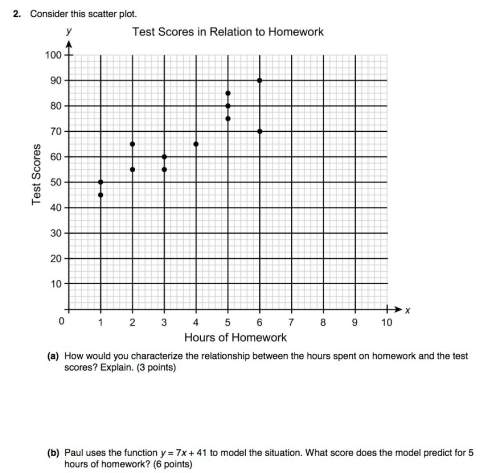
Mathematics, 27.01.2021 19:40 hannahkharel2
Is this an flvs question and can this be explained
A ball is dropped from a certain height. The function below represents the height f(n), in feet, to which the ball bounces at the nth bounce:
f(n) = 9(0.7)n
What does the number 0.7 represent?
The ball bounces to 30% of its previous height with each bounce.
The height at which the ball bounces at the nth bounce is 0.3 feet.
The ball bounces to 70% of its previous height with each bounce.
The height from which the ball was dropped at the nth bounce is 0.7 feet.

Answers: 2


Another question on Mathematics

Mathematics, 21.06.2019 19:10
The linear combination method is applied to a system of equations as shown. 4(.25x + .5y = 3.75) → x + 2y = 15 (4x – 8y = 12) → x – 2y = 3 2x = 18 what is the solution of the system of equations? (1,2) (3,9) (5,5) (9,3)
Answers: 1

Mathematics, 21.06.2019 19:30
You have learned about the six trigonometric functions, their definitions, how to use them, and how to represent them graphically. the sine, cosine, and tangent trigonometric functions can be paired with their reciprocal functions, cosecant, secant, and cotangent, respectively. think about how each function is related to its reciprocal function.how are the graphs of the reciprocal functions related to their corresponding original functions? what happens to the graphs of the reciprocal functions as x approaches the zeros of the original functions? describe how you would teach friends with different learning styles (visual-spatial, aural-auditory, verbal-linguistic, physical-bodily-kinesthetic, logical-mathematical, social-interpersonal, and solitary-intrapersonal) how to graph the reciprocal functions
Answers: 2

Mathematics, 21.06.2019 20:30
Drag the tiles to the correct boxes to complete the pairs. not all tiles will be used. match each division expression with the correct quotient.
Answers: 2

Mathematics, 21.06.2019 21:30
In a test for esp (extrasensory perception), a subject is told that cards only the experimenter can see contain either a star, a circle, a wave, or a square. as the experimenter looks at each of 20 cards in turn, the subject names the shape on the card. a subject who is just guessing has probability 0.25 of guessing correctly on each card. a. the count of correct guesses in 20 cards has a binomial distribution. what are n and p? b. what is the mean number of correct guesses in 20 cards for subjects who are just guessing? c. what is the probability of exactly 5 correct guesses in 20 cards if a subject is just guessing?
Answers: 1
You know the right answer?
Is this an flvs question and can this be explained
A ball is dropped from a certain height. The fun...
Questions







Mathematics, 21.07.2019 00:00


Mathematics, 21.07.2019 00:00

English, 21.07.2019 00:00

Social Studies, 21.07.2019 00:00



Social Studies, 21.07.2019 00:00


Biology, 21.07.2019 00:00


Mathematics, 21.07.2019 00:00


History, 21.07.2019 00:00




